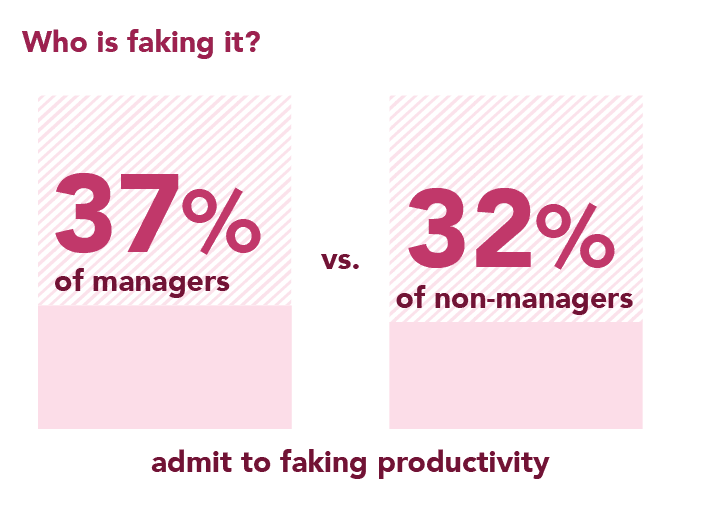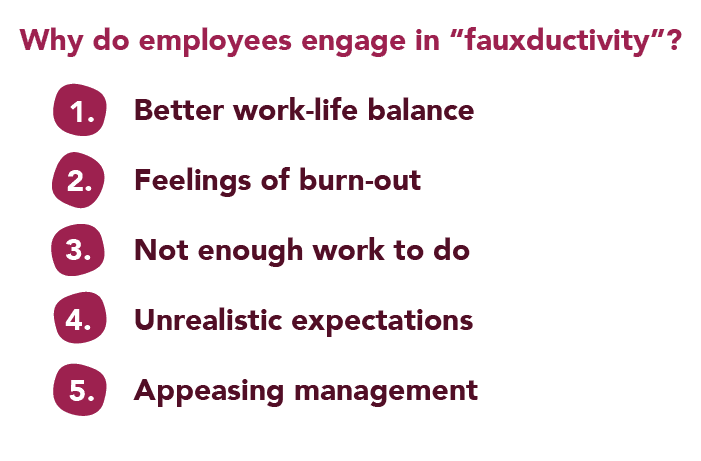Is the Faux-Productivity Problem Real or Imagined?

The market has been abuzz with conversations on productivity—more specifically, the lack thereof. With trends like quiet vacationing and the Great Detachment top of mind, it's no wonder that Fortune 500 CEOsOpens in a new tab ranked low productivity as the biggest organizational challenge for 2024. In this quarter’s Global Human Workplace Index survey, we asked 3,000 full-time employees in the US, UK, and Ireland about their work tracking habits, perceived productivity, and relationship with their manager.
Our main focus was on “faking activity or productivity”, -- aka, fauxductivity. It's no secret productivity is dipping—but is it because employees are “faking it” using mouse-jigglers and falsified timesheets? Or is there another culprit at the root of falling productivity?
The fauxductivity phenomenon is, well, faux
The results are in: the majority of employees are not faking activity. Our survey revealed that 67% of respondents deny they fake activity.
If you ask their managers, though, it seems the jury is still out, with 48% of managers saying that faking activity is a common issue on their team.
Go deeper, and you find that more often, leaders themselves are driving the phenomenon, with 38% of C-Suite executives admitting to faking activity, and 37% of all managers engaging in fauxductivity-- higher than the 33% average of all respondents, and 32% of non-managers.
What does this mean? Managers and leaders are the stewards of company culture. Our survey reveals that they’re faking productivity more than their non-manager counterparts, revealing that the pressure to perform might be coming from the top-down.

Of the managers who admitted to faking activity, 69% say faking activity is a common issue on their team, versus 37% of managers who do not fake activity.
This shows fauxductivity might be a symptom of poor culture, creating a toxic cycle of performative productivity and productivity anxiety.
Why the performance?
A portion of workers do feel the need to fake activity. But what’s the root cause, and what are they up to when the green light on Slack claims they’re online?
The top two reasons employees reportedly feel the need to fake activity connect to low wellbeing. Suffering from low wellbeing can lead to worse outcomes for employees’ professional and personal lives. The impulse to fake activity due to wellbeing-related reasons indicates that employees aren’t in a company culture where they feel comfortable to voice when they need to step away.

If the majority of employees aren’t faking activity, it could be that low wellbeing, not fauxductivity, is to blame when it comes to C-level concerns about productivity. In fact, our findings revealed that employees engaging in fauxductivity aren’t concerned about it affecting their performance:

69% of employees also say that faking productivity hasn’t impacted their day-to-day work. Low wellbeing, however, can impact performance. In a separate study, Workhuman and Gallup found that low wellbeing-fueled burnout costs $322 billion to businesses globally in the form of turnover and lost productivity.
Managers believe that distractions are a major cause of employee faking, but they also acknowledge wellbeing-related issues top the list:
For managers who admitted to faking activity, their top reasons included:
- Better work-life balance
- Appease management
- Burnout
It’s an understatement to say that today’s employees are up against a lot: both professional and personal stressors, burnout, overwork and disengagement can contribute to low wellbeing. In order to properly support employees in this climate, it’s essential to cultivate a culture of psychological safety. Managers especially are in the position to promote a workplace culture that allows employees to be human and say when they’re struggling—not turn to performative productivity. That means managers themselves need to resist the urge to keep up appearances and instead be vocal about when they’re taking a break. The re-energized, re-committed people that return to work after recharging will achieve better outcomes and better wellbeing than those who stay quiet and stay online.
The toll “always on” takes
While many acknowledge that work has changed in the recent years—from the widespread adoption of remote work during the pandemic to advancements in technology that make it possible to complete the majority of work from anywhere, at any time— these newfound capabilities have some unintended consequences:
- Over 50% of respondents say they’re expected to immediately respond to all Slacks, messages, or emails
- 52% also said that they’re expected to be flexible with their working hours to accommodate after-hours meetings.
When employees feel they need to be “always on,” it can exacerbate a toxic cycle of overwork and burnout. This is especially true when employees feel they need to account for every second with some form of time tracking.
For online workers whose companies do not require time-tracking, 66% say they have not pretended to be active and productive, compared to the 60% of online workers who say their companies require some form of time-tracking.
Does this mean time-tracking in all its forms is a no-go for organizations? Not necessarily. A company culture that reiterates output over input—or, in other words, the quality of work and results over the quantity of hours spent online or at a desk—can be key in taking some of the pressure away from employees caught in a fauxductivity charade.
Manager involvement can make it or break it
When asked how manager involvement affects their work, 62% of employees who reported that they had frequently-involved managers said that involvement helps them do their job.
Key finding: Of the respondents who said their managers are extremely involved, the majority (61%) said they are always engaged at work, but that number drops to 26% when managers have little to no involvement in their work.
The top-selected side effect of manager involvement for this low involvement group was that managers “cause unnecessary stress,” which 37% of that cohort said.
Involvement informs the self-evaluation of performance as well:
- Of respondents with “extremely involved” managers, 49% rated themselves as a high achievers
- When respondents said their manager was “slightly” or “not at all” involved, only 22% rated themselves as high achievers
So what? This signals that too little guidance/understanding of what success is and examples set by managers means more stress for employees. Creating an effective feedback loop with employees is the best step managers can take to help support employees, set expectations, and invite more engagement.
It’s incredibly important for managers to show up in their direct reports’ work life as sources of support, not of stress. This starts with creating moments of connection through frequent feedback. Opening the line of communication to mentor, problem-solve, and recognize employees can help create a positive and supportive company culture, and bolster employee wellbeing. Demonstrating what “good” looks like by reinforcing certain employee habits and behaviors is the best way to build connection while also promoting company values that will help employees drive toward the business bottom line and know their work is an important part of success.
54% of respondents said that when they’re not engaged, their coping strategy is to do the bare minimum to get through the day and complete what they can. Disengaged work does not spell success for your business.
Recognition is the key to fostering authentic engagement, as well as a culture of psychological safety that allows workers to admit when they need a break to heal from burnout or reorient their work-life balance, instead of skating by with “fauxductivity”.
By demonstrating what success looks like, focus can shift from time spent at your desk to more meaningful outputs that impact the highest goals and values of the business.



